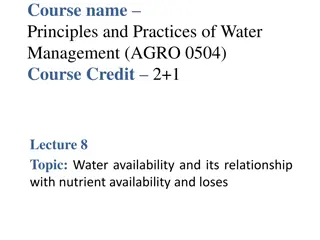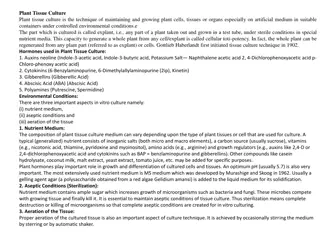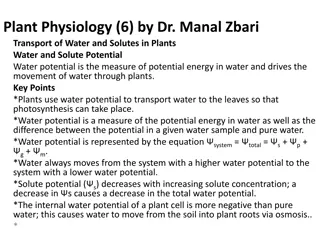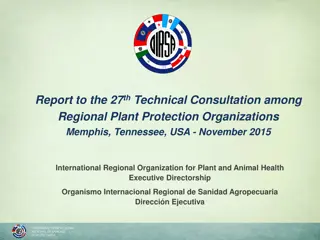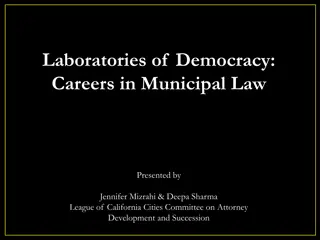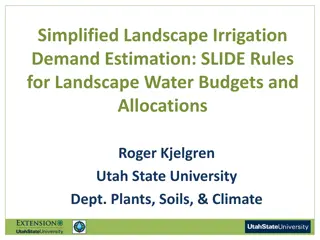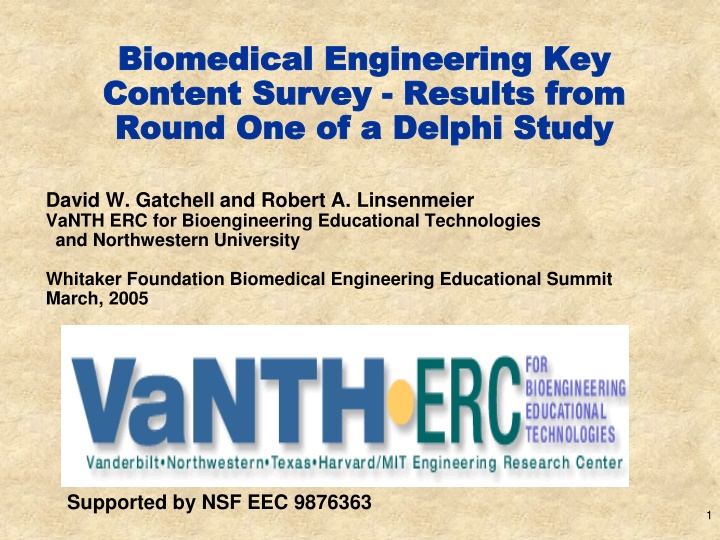
Plant Capacity and Municipal Water Demand Fluctuations
The design capacity of a water treatment plant is crucial for meeting future demand projections, which are often based on population growth and per capita water usage. Understanding fluctuations in municipal water demand is essential for efficient supply management and infrastructure planning.
Download Presentation

Please find below an Image/Link to download the presentation.
The content on the website is provided AS IS for your information and personal use only. It may not be sold, licensed, or shared on other websites without obtaining consent from the author. If you encounter any issues during the download, it is possible that the publisher has removed the file from their server.
You are allowed to download the files provided on this website for personal or commercial use, subject to the condition that they are used lawfully. All files are the property of their respective owners.
The content on the website is provided AS IS for your information and personal use only. It may not be sold, licensed, or shared on other websites without obtaining consent from the author.
E N D
Presentation Transcript
Biomedical Engineering Key Biomedical Engineering Key Content Survey Content Survey - - Results from Round One of a Delphi Study Round One of a Delphi Study Results from David W. Gatchell and Robert A. Linsenmeier VaNTH ERC for Bioengineering Educational Technologies and Northwestern University Whitaker Foundation Biomedical Engineering Educational Summit March, 2005 Supported by NSF EEC 9876363 1
Why conduct a BME key content survey? Motivation and potential benefits Motivation Establish an identity for undergraduate Biomedical Engineers Improve communication between academic BME programs and industry Academia Inform industry of the knowledge, skills and training of BMEs Industry Inform academia of the knowledge, skills and training expected Benefits More industrial positions for BMEs Each graduate does not have to explain curriculum Recognition that BME degree is ideal preparation for at least some industrial positions. 2
Delphi study - Overview In General: An iterative process for collecting knowledge from, and disseminating results to, a group of experts Four steps (repeat steps #2 and #3 to attempt to reach consensus) 1. Develop a set of questions on a topic. 2. Experts give opinions on topics; suggest new ideas that were missed 3. Explore and evaluate inconsistencies uncovered in step 2 4. Disseminate findings, or revise questions and go back to 2 Key point is that experts remain anonymous Our Study: A set of three surveys Round 0: Select concepts from VaNTH taxonomies; reviewed by domain experts Round 1: Survey BME industrial representatives and faculty. Asked participants to rate relevance of concepts important for ALL undergrads in BME, and make suggestions of concepts missed Round 2: Refine and update list of concepts and resubmit to the above groups for further evaluation Round 3: Question proficiencies expected (e.g., using Bloom s Taxonomy) 3
Overview of the key content survey, round one Utilized an online survey tool to query ~274 concepts: Eleven bioengineering domains (including design) Physiology, cellular biology, molecular biology and genetics, biochemistry Mathematical modeling, statistics, general engineering skills (e.g., computer programming) Survey divided in two parts, each with half the domains: Total number of participants, n = 136 Part one: Academia 42, Industry 25 Part two: Academia 35, Industry 23 Participants were asked to: Provide demographic information Employer, Job Title, Responsibilities, Years of Experience Self-assess level of expertise in each domain (e.g., Biomechanics) Rate the importance/relevance of each concept to a BME core curriculum Suggest concepts that had not been included 4
Overview of the key content survey Concepts rated on 5 point Likert Scale 1- very unimportant for all BMEs 5 very important for all BMEs Mean ratings across concepts similar for industry and academia Academia (n=77) mean and SD rating: 3.71 0.52 Industry (n=48) mean and SD rating: 3.75 0.41 Domains Investigated: Bioinformatics, bioinstrumentation, biomaterials, biomechanics, biooptics, biosignals and systems, medical imaging, thermodynamics, transport (fluid, heat, mass) Cell biology, biochemistry, molecular biology and genetics, physiology Statistics, general engineering 5
Some concepts included as Ringers Some concepts included as Ringers - - Expected to have low rating Expected to have low rating Concept Rating (Academia) 2.32 Rating (Industry) 2.58 Statistical Physics (e.g., Bose-Einstein statistics; Fermi-Dirac statistics) Statistical Physics (e.g., Partition function; statistical representation of entropy; population of states) Comparative Genomics (e.g., ortholog and paralog genes; gene fusion events) Dynamical Instability and Chaos 2.82 2.58 2.50 2.94 2.59 3.11 Unsteady state mass diffusion equation (e.g. Fick s second law; production and consumption; boundary conditions; different geometries; multiple layers) 3.42 3.29 All except unsteady state mass diffusion equation met expectations 6
Some concepts included in more than one Some concepts included in more than one domain to check consistency of response domain to check consistency of response Two values shown are ratings when concepts are included in different domains Generally good agreement, but rating sometimes depended on context Concept Ratings (Academia) Ratings (Industry) Databases - Interfaces and Structures (e.g., MySQL, relational tables, simple queries, PERL, CGI, DBI) Signal Processing to Reduce Noise (e.g., signal-to-noise ratio; signal averaging) Properties of Systems (e.g., boundary, surroundings, universe) Electrochemical Potential, Nernst Potential, Fick's Law 2.29/2.66 3.22/3.68 4.24/3.83 4.17/4.14 3.88/3.97 3.63/3.88 4.09/4.23 3.54/4.00 7
Results: Highest rated engg concepts Academia Orange concepts are from statistics and general engineering Concept Rating 4.69 Hypothesis Testing (e.g., paired and un-paired t-tests; chi-square test) 4.68 Principles of Statics (e.g., forces; moments; couples; torques; free- body diagrams) Descriptive Statistics (e.g., mean, median, variance, std deviation) 4.63 4.56 Circuit Elements (e.g., resistors, capacitors, sources, diodes, transistors, integrated circuits) DC and AC circuit analyses (e.g., Ohm's and Kirchoff's laws) 4.56 4.54 Mathematical Descriptions of Physical Systems (e.g., functional relationships, logarithmic, exponential, power-law; ODEs; PDEs) Strength of Materials (e.g., stress, strain; models of material behavior) 4.53 Pressure-Flow Relations in Tubes and Networks (e.g., flow rate = [change in pressure]/resistance; Poiseiulle relation; Starling resistor) 4.51 4.50 Measurement concepts (e.g. accuracy, precision, Regression analysis 4.49 4.49 Forces and pressures in fluids (e.g. shear, normal, surface tension 8
Results: Highest rated engg concepts Industry Orange concepts are from statistics and general engineering Concept Rating Descriptive Statistics (e.g., mean, median, variance, standard deviation) Measurement Concepts (e.g., accuracy, precision, sensitivity; error analysis - sources, propagation of error) Hypothesis Testing (e.g., paired and un-paired t-tests; chi-squared) Probability Distributions (e.g., normal, Poisson, binomial) 4.76 4.71 4.65 4.62 Strength of Materials (e.g., stress, strain; models of material behavior) 4.57 Fundamental Properties of Polymers, Metals and Ceramics Product Specification (e.g., requirements, design, reliability, evolution/tracking of the product) Principles of Statics (e.g., forces; moments; couples; torques; free- body diagrams) Mechanical Properties of Biological Tissues (e.g., elastic; viscoelastic, hysteresis, creep, stress relaxation) Data Acquisition (e.g., sampling rates and analog-digital conversion; Nyquist criterion; aliasing) 4.50 4.45 4.43 4.43 9 4.39
Results: lowest rated concepts Results: lowest rated concepts some from Ringers Academia Databases - Interfaces and Structures (e.g., MySQL, relational tables, simple queries, PERL, CGI, DBI) Statistical Physics (e.g., Bose-Einstein and Fermi-Dirac statistics) 2.29 2.32 Artificial Intelligence (e.g., artificial neural networks, fuzzy logic) Analysis of Phylogenetic Trees, Molecular Evolution 2.33 2.47 Comparative Genomics (e.g., ortholog and paralog genes; gene fusion events) Structural Prediction and Molecular Design 2.50 2.53 Industry 2.58 Statistical Physics (e.g., Partition function; statistical representation of entropy; population of states) Statistical Physics (e.g., Bose-Einstein; Fermi-Dirac statistics) 2.58 2.78 2.89 2.94 2.95 Artificial Intelligence (e.g., artificial neural networks, fuzzy logic) Storage Instruments and their properties (e.g., tape, disk, memory) Comparative Genomics 10 Root Locus Plots (e.g., definition, properties, sketching)
Results: Industry Results: Industry - - Academia agreement Academia agreement Distribution of mean ratings of all concepts Distribution of mean ratings of all concepts 5.00 4.00 Industry 3.00 Concept Ratings 2.00 2.00 2.50 3.00 3.50 4.00 4.50 5.00 Academia Most concepts rated highly. Few ringers in survey. All traditional domains had some highly rated concepts. Cutoff level for inclusion in recommended undergrad curriculum still to be determined on basis of further analysis and round two. 11
Results: Industry Results: Industry Academia Agreement Academia Agreement Differences in means (A Differences in means (A- -I) I) 0.75 Differences in Mean Responses 0.50 0.25 0.00 -0.25 -0.50 -0.75 Design -1.00 -1.25 0 50 100 150 200 250 Concept # 12
Results: Discrepancies in design Results: Discrepancies in design concepts concepts Rankings - BME Design Concepts (A comparison of opinions from Academia and Industry) Decision Matrix Approaches to Initial Design Design for Manufacturing and Assembly Software for Design and Project Management (e.g., flowcharting; Gannt and PERT charts) Industry Academia Software and Process Design Considerations Risk Analysis/Hazard Analysis Computer-Aided Design Considerations Human Factors Issues/FDA 1.00 2.00 3.00 4.00 5.00 Mean Ranking (all participants) 13
Results: A comparison of general Results: A comparison of general engineering concepts engineering concepts Databases - Interfaces and Structures (e.g., MySQL, relational tables, simple queries, PERL, CGI, DBI) Ringer Artificial Intelligence (e.g., artificial neural networks, fuzzy logic, etc.) Familiarity with Multiple Computing Platforms (e.g., Windows, Macintosh, LINUX, UNIX) Significant Deltas Scaling and Dimensional Analysis Numerical Differentiation and Integration Industry Academia Generalized Ohm's Law (i.e., driving force-flow-resistance concept) Competency with (at least) One Programming Environment (e.g., Matlab, Mathematica, C, C++, FORTRAN) Estimation and Order of Magnitude Calculations Measurement Concepts (e.g., accuracy, precision, sensitivity; error analysis - sources, propagation of error) 1.00 2.00 3.00 4.00 5.00 Mean Rating (all participants) 14
Results: Biology Domains Results: Biology Domains 5.0 Rating of Concept - Industry 4.5 4.0 Biochemistry Cell Biology Molecular Biol. Bioinformatics Unity slope 3.5 3.0 2.5 2.5 3.0 3.5 4.0 4.5 5.0 Rating of Concept - Academia Good agreement on the whole All biology areas important, but industry sees molecular biology as being more important than academia Bioinformatics generally scored low, but industry feels that it is more important than academia does 15
Results: Largest biology Results: Largest biology discrepancies discrepancies Concepts Academia Industry Academia - Industry Flow of Genetic Information (i.e., DNA to RNA to Protein) Methods for Determining Macromolecular Structure (e.g., NMR...) DNA Microarrays Biological Networks (e.g., genetic networks...) Structural Prediction and Molecular Design (e.g., homology modeling and prediction of macromolecular structures and interactions) 4.5 4.1 0.44 3.5 4.2 -0.70 3.4 3.2 3.8 3.7 -0.42 -0.46 2.5 3.3 -0.72 16
Results: Physiology (82 concepts) Results: Physiology (82 concepts) Very large span within domain 5.0 Rating of Concept - Industry 4.5 Generally good agreement 4.0 Cardiovascular, neural, cellular physiology concepts rated highly 3.5 Physiology Unity slope 3.0 Digestive, renal, parts of endocrine rated low 2.5 2.5 3.0 3.5 4.0 4.5 5.0 Rating of Concept - Academia 17
Results: Largest physiology Results: Largest physiology discrepancies between academia and discrepancies between academia and industry industry Concepts Academia Industry Academia - Industry 0.41 Cellular Anatomy (e.g...) 4.56 4.14 Membrane Dynamics (e.g....) 4.44 3.95 0.49 Processes of the Kidney (e.g....) 4.26 3.85 0.41 Renal Filtration (e.g...) 4.03 3.60 0.43 Homeostasis of Volume and Osmolarity Water Balance and Urine Concentration 4.03 3.50 0.53 3.73 3.25 0.48 Platelets and Coagulation (e.g....) 3.21 3.75 -0.54 Sodium Balance and the Regulation of ECF Volume (e.g....) 3.76 3.15 0.61 18
Results: Should the following Results: Should the following foundational courses be required? foundational courses be required? Comparison of Responses - Industry and Academia Physics - Waves and Optics Physics - Electricity and Magnetism Physics - Mechanics Chemistry - Organic (Semester Two) Industry Academia Chemistry - Organic (Semester One) Chemistry - General Ordinary Differential Equations Linear Algebra Vector Calculus Calculus - Differential, Integral and Multivariate "NO" "UNSURE" "YES" Agreement that second semester organic chemistry is not universally required; some uncertainty about one semester 19
Universities represented in round one Universities represented in round one of the survey of the survey 1. 2. 3. 4. 5. 6. 7. 8. 9. 10. 11. 12. 13. 14. 15. 16. 17. 18. 19. Arizona State University* Binghampton University Boston University* Columbia University Devry Institute of Tech Duke University* Florida International University IIT Johns Hopkins University* Marquette University* Milwaukee SOE* MIT NJIT NC State University* Northwestern University* RPI* RHIT Stanford University Syracuse University* 20. 21. 22. 23. 24. 25. 26. 27. 28. 29. 30. 31. 32. 33. 34. SUNY Stony Brook Tulane University* University of Akron* University of Cincinnati University of Illinois UC* University of Iowa* University of Memphis University of Michigan University of Minnesota* University of Pittsburgh* University of Rochester* University of Texas Austin* University of Toledo* Vanderbilt University* VCU* *ABET Accredited 21 of 37 Accredited Programs Participated 20
Companies and industrial expertise Companies and industrial expertise represented in round one of the survey represented in round one of the survey Companies Represented Abbott Laboratories AstraZeneca Baxter Healthcare Boston Scientific Cardiodynamics Cleveland Medical Devices Datasciences, International Dentigenix, Inc. Depuy, a Johnson and Johnson Co. ESTECH Least Invasive Cardiac Surgery GE Healthcare Intel, Corp. Materialise, Inc. Medtronic, Inc. Tyco Healthcare Underwriter Laboratories Areas of Expertise Biomaterials Biomechanics Bioinformatics Bioinstrumentation BioMEMS Biotransport Cellular Biomechanics Computational Modeling Control Systems Engineering Fluid Mechanics Medical Devices Medical Imaging Medical Optics Signal Processing 21
Conclusions Conclusions More analysis is required to: Investigate variation of opinions for individual topics Correlate ratings with expertise levels Eliminate contextual bias Incorporate concepts omitted from first round BUT, preliminary results have shown that: Consistency checks validate data Generally good agreement between industry and academia Industry and academia disagree on a significant number of Design concepts Industry highly values knowledge of statistics and probability Core biology should include all domains assessed 22
Conclusions Conclusions Remaining issues Determine level of significance for deciding what concepts can be dropped from core curriculum Determine significance of differences between industry and academia Launch second round by summer Full matrix of results by concept will be posted on www.vanth.org/curriculum 23


